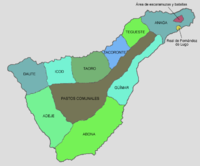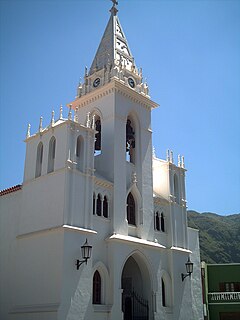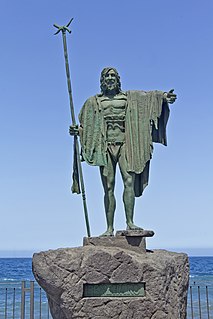
Daute was one of nine menceyatos guanches (native kingdoms) that was divided the island of Tenerife (Spain) after the death of King Tinerfe, in the period before the conquest of the islands by the Crown of Castile.

Guanches were the aboriginal inhabitants of the Canary Islands. In 2017, the first genome-wide data from the Guanches confirmed a North African origin and that they were genetically most similar to modern North African Berber peoples of the nearby North African mainland. It is believed that they migrated to the archipelago around 1000 BCE or perhaps earlier.

Tenerife is the largest and most populated island of the seven Canary Islands. It is also the most populated island of Spain, with a land area of 2,034.38 square kilometres (785 sq mi) and 904,713 inhabitants, 43 percent of the total population of the Canary Islands. Tenerife is the largest and most populous island of Macaronesia.

Spain, officially the Kingdom of Spain, is a country mostly located in Europe. Its continental European territory is situated on the Iberian Peninsula. Its territory also includes two archipelagoes: the Canary Islands off the coast of Africa, and the Balearic Islands in the Mediterranean Sea. The African enclaves of Ceuta, Melilla, and Peñón de Vélez de la Gomera make Spain the only European country to have a physical border with an African country (Morocco). Several small islands in the Alboran Sea are also part of Spanish territory. The country's mainland is bordered to the south and east by the Mediterranean Sea except for a small land boundary with Gibraltar; to the north and northeast by France, Andorra, and the Bay of Biscay; and to the west and northwest by Portugal and the Atlantic Ocean.
Occupied by the extension of the existing municipalities of El Tanque, Los Silos, Buenavista del Norte and Santiago del Teide and menceys were Cocanaymo and Romen. [1]

El Tanque is a town and a municipality in the northwestern part of the island of Tenerife, one of the Canary Islands, and part of the province of Santa Cruz de Tenerife, Spain. It is located 6 km west of Icod de los Vinos and 53 km west of the island's capital Santa Cruz de Tenerife.

Los Silos is a municipality and town in the northwestern part of the island Tenerife, Canary Islands, Spain. It is located on the north coast, 57 km West of the capital Santa Cruz de Tenerife.

Buenavista del Norte is a municipality and town on the north coast of Tenerife. It is located on the TF42 Road, about 75 km west of the capital Santa Cruz de Tenerife, and 65km from Tenerife North Airport.








